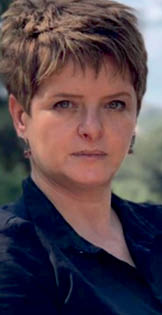In a small area of a few hundred meters in Wadi Salib, near the sea that carried thousands of people to refugee camps 70 years ago, abandoned homes stand still. Families left their homes in a moment of panic, in hopes that they would return a short while later. Their large arched windows and doors, which were once wide open to life, have been sealed with bricks and concrete. With closed outlets and blocked sunlight, these homes stand by the sea – mute, cold, and grey. They are a graveyard; their closed windows are tombstones, engraved with the name of the first inhabitant, his date of birth, the names of his wife and children, and their ages when they walked out of the house. When the sun was blotted out, they left their shadows behind and wandered in exile. Tales say they grew up, got old, and died. Still, their shadows that stayed there remained young, waiting for a kiss from the promised returnee.
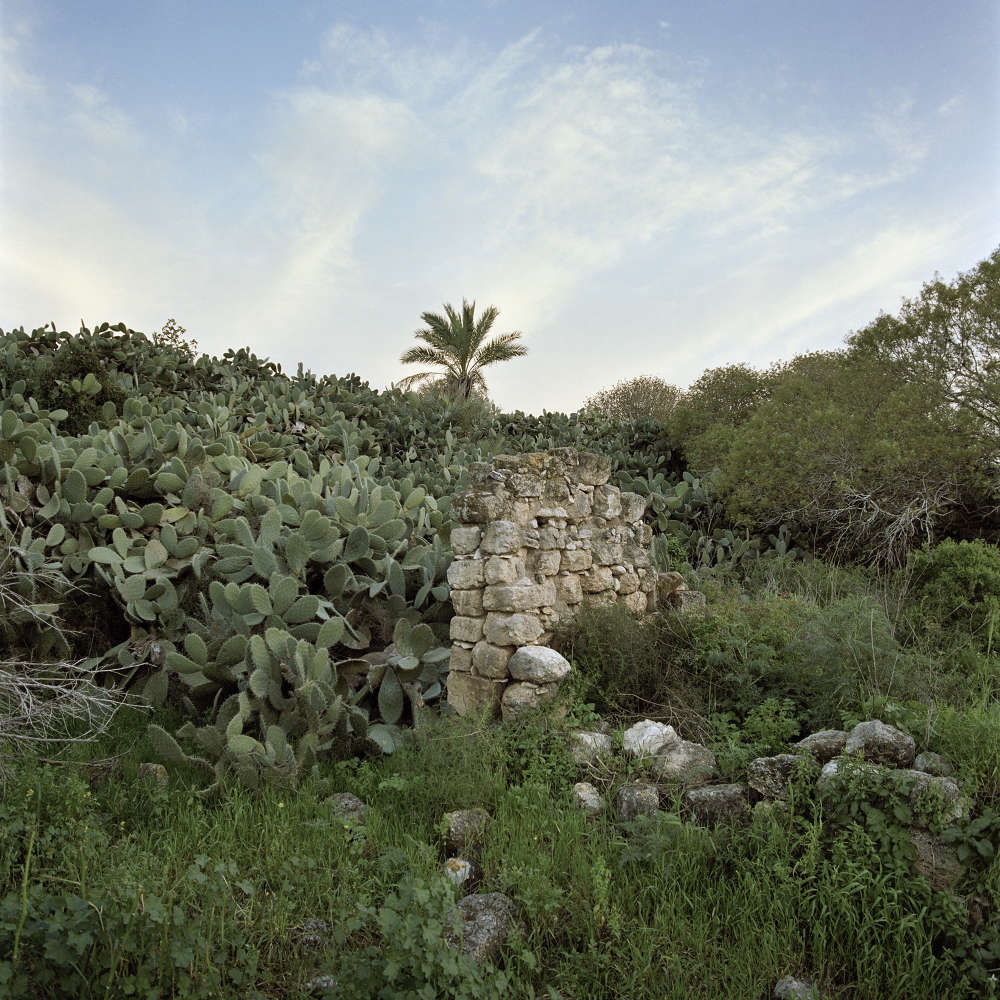
Hawsha was a Palestinian village located 13 kilometers east of Haifa. In 1945, it had a population of 580 inhabitants, 400 of whom were Arab Muslims and 180 of whom were Jewish. Hawsha was depopulated on April 16, 1948, during the war, as part of the Battle of Ramat Yohanan, when the Haganah fought against the Arab Liberation Army. The Arab inhabitants who remained in the village following its defeat were evicted, as were those of neighboring villages. Photo by Bruno Fert.
It is not easy to write about the Nakba. We are the grandchildren of those who remained in this place and witnessed how the country changed its skin, turning into tyrannical estrangement. We write about an experience, the repercussions of which we endure in the form of constant probabilities of a further catastrophe. It is like a bird who is caught in a trap but does not know how to walk out unscathed. Hence, it is easy for us to turn to literature, to write while we oscillate on the edge between the language of poetics and research. We attempt to write with scientific prudence so as not to be accused of being poetic, prejudiced, or nonobjective. But the mute homes and ruins of the homeland expand further in the echo of writing. This way, words are as heavy as the loss. Language is involved with us in the melancholy of the narrative. It is, then, inevitable to write about the Nakba on the boundaries between literature and sociology. Both are indispensable to catch, touch, and find a sense of meaning.
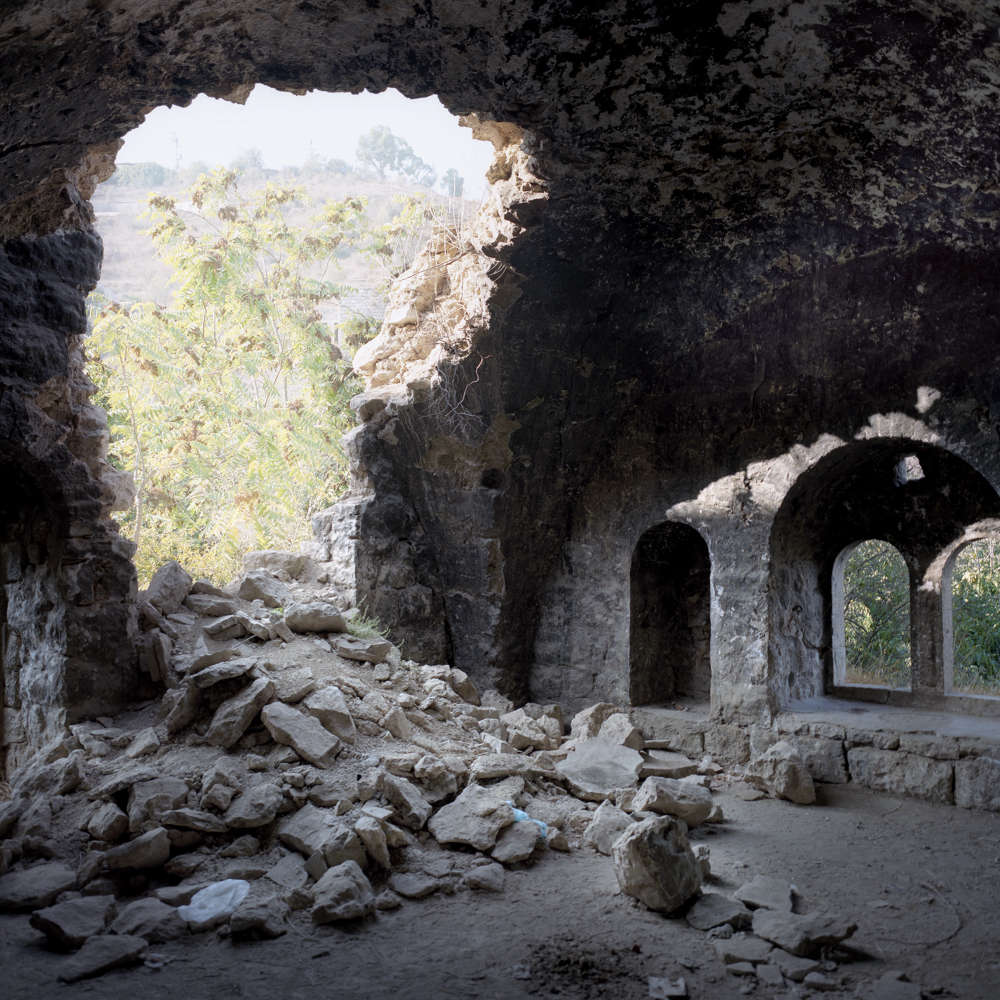
In the 1940s, 3,000 inhabitants lived in Lifta, on the outskirts of Jerusalem. This village was known to be one of the wealthiest communities in the Jerusalem area. The former villagers of Lifta were driven out during the Arab-Jewish hostilities in January 1948. In 2012, former inhabitants of Lifta won a legal battle to stop plans for the construction of a luxury housing development on the ruins of their village. Photo by Bruno Fert.
Not much has remained in the afflicted village of Tantura. But Al-Madhi Palace, with its large arches and vast yard, is still in place. It is an eyewitness to a colorful, jubilant past, well before the Nakba. Of all buildings in the village, it has been left alone. It is not easy to demolish a house as beautiful as Al-Madhi’s, even if you are an enemy. A lonely house that survived the massacre perpetrated against the other houses of the village and its fine young people. It is an exception that confirms the rule that has guided Israeli policy towards Palestine: erase as much as you can of the human, physical, and symbolic elements of the Palestinian landscape – the Palestinian human being, the Palestinian home, and Palestinian history and culture. Then, build a new landscape on the rubble, using new Jewish elements.
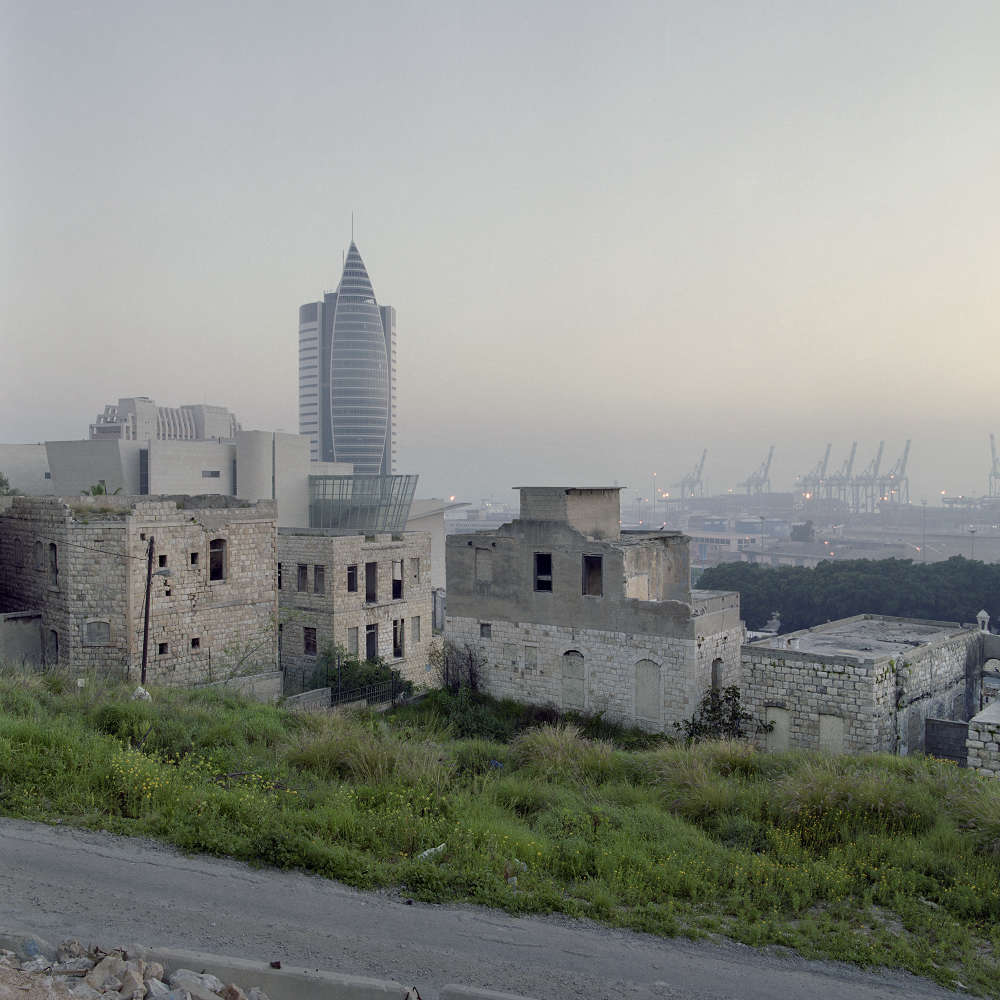
Abandoned houses seen in the Wadi Salib neighborhood of Haifa. Most of the inhabitants of Wadi Salib left or were evicted by Zionist forces during the “Passover Cleaning” operation (Bi’ur Hametz) in April 1948. After the 1948 War, Moroccan Jewish immigrants were housed in the vacant houses of Wadi Salib. In 1959, they rebelled against Israeli authorities to demand better housing. Photo by Bruno Fert.
The ruins of more than 500 villages, most of which were razed to the ground, are scattered around Palestine, which was stricken by the Nakba in 1948. After almost 70 years of displacement, the sites of most of these villages can be located: remains of large stones tell of the houses that were ravaged by the colonizer; cactus grows everywhere – a guard! If a leaf of this cactus dies, three more will bloom in its place. If uprooted by the colonizer, it grows even more abundantly.
The ruins tell the story of the dialectic of demolition and construction in a colonization process.
In the midst of high residential towers in Haifa, abandoned homes lie asleep. On the hills surrounding the kibbutzim near Ramla and Lydda, the ruins of demolished villages spread out. On the Tel Aviv beach, which is chock-full of hotels and bars, Sidna Ali Mosque stands aloft. In Caesarea, ruins were replaced by stone houses. The minaret is still there, but the mosque has been turned into a restaurant and bar. In Talbiya, Qatamon, and Ein Karem, homes of the indigenous people have remained unchanged, but they are now inhabited by the alien invaders. This is not the case with Lifta, which lies at the foot of a mountain at the gateway to Jerusalem: the homes of its displaced families are in place, ruined, abandoned, and cold.
These scattered remains and ruins are the archive of afflicted Palestine. To write down the history of the Nakba, we must research, monitor, and investigate these ruins. Such history will not be reflected as an incident, but rather as an ongoing, incremental process that constitutes the attempted act of erasure. And it is Israeli policy to maintain and entrench erasure until it turns into a marginal act within the structure of the state. In this context, we can, for example, pose probing questions to investigate the house that was sealed with concrete in Wadi Salib: Who were your inhabitants? Where did they go? How and when did they walk out? Where are they now? What has become of them? We can ask phenomenological questions: How do the inhabitants speak about their home? How do they tell its story? How do they pass its pictures on to their children? How did they experience living in it? We can ask historical-sociological questions: How did they share the rooms? Who built the house and laid the stones? Who designed the corners? Who distributed and took care of the hawakeer (lands)? What types of trees were planted? Why this type, in particular? Then, I would ask it socio-political questions: Who sealed your windows? Who kept the air out? Who prevented your inhabitants from returning to you? Who is your new master? Where did he come from? How has he built his sovereignty? What are his claims? Also, I would ask it about pictures of the place: How did time stand still at the time of the Nakba, when it intersected with colonial implantation? At the intersection of shadow and darkness in the house sealed with cement, what was born in your dark rooms?
Thus, the archive of ruins constitutes a discipline that blossoms at the intersection of poetry and sociology. It is reflected by researchers who stand on the periphery of the various experiences of Nakba, wandering between the agony of alienation and exiles, as experienced by those stricken by the Nakba and expressed in poetry on the one hand, and on the other hand the theory of sociological examination of the construction and building of homes – with all their associated meaning in Palestinian society – in light of the major transformations caused by the Nakba! Both poetry and sociological theory are indispensable when we aim to investigate and understand the Nakba.
As Australian researcher Patrick Wolf puts it, ruins are an alibi to the structural relationship between erasure and construction in settler colonial states. The colonizers who wish to shape their new sovereign society on inhabited land seek to eliminate the existing indigenous landscape and replace it with a new one. In this context, removal of Palestinians from the land on which they live remains an irreducible prerequisite to the establishment of Israeli hegemony. The essence of the Zionist project dictated that Israel was to be proclaimed on the land of Palestine after the erasure of Palestine as a culture and nation. On the ground, Palestine was silenced by the destruction of villages, homes, and streets, the removal of humans from the place, and the building of cities, streets, and institutions on the ruins. The colonizers sculpted a history, a discourse, symbolic incubators, and constituent legends. New names and a new map replace the familiar ones. Names are an echo of the intended narrative – Hebraicized, Judaized, and engineered to fit with the imagination that was carefully created to serve as a new starting point on the rubble and ruins of Palestine!
Despite the anguish, destruction, and fragmentation it caused, can the Nakba serve as a condensation point that leads Palestinians from destruction to construction?
Ruins are not a metaphor. Erasure is not an exception but the foundational component in the Zionist project. In Walter Benjamin’s terms, the ethnic cleansing in 1948 was “lawmaking violence” that preceded the declaration of Israel as the new state that was established on Palestinian ruins. Lawmaking violence, in contrast to law-preserving violence, was directed towards the demolition of the current Palestinian indigenous order in order to replace it with a new one that is dominated by Jews. Already in the Mandate era, by applying the ethnic-cleansing methods of transfer and through the destruction of cultural, political, and social institutions, Zionists prepared the ground for the establishment of the new colonial order that was manifested in the declaration of the state of Israel in 1948. Later, “law-preserving” violence was used in the form of denial of the right of Palestinians to return, the recruitment of Jewish immigrants, and the provision of guidance to state institutions and violence agencies, as well as in the drafting of basic laws and other tools that followed the establishment of Israel. It was utilized to maintain the “new” colonial order as a “Jewish nation-state” in a land from which the Palestinian indigenous population had already been removed.
At the intersection of the idea and materialization of the Jewish nation-state on the land of Palestine, which is inhabited by a population who looks for self-determination, building the Jewish nation-state has, from its inception, combined settler colonial tools. Premised on the dichotomy of erasure and construction, settler colonialism to this day works toward erasing the existing (Palestinian) as a group that aspires to sovereignty, and implanting the new (Jewish) as a sovereign political entity, which is eager to replace the Palestinian. Hence, early Zionist settlements were beyond the law of the indigenous population. Under the protection of Mandate Rule, their own institutions, laws, and regulations were put into effect. In 1948, these were transformed into institutions, legislation, and, more importantly, state sovereignty. In other words, the process of establishing the Jewish nation-state involved implantation of the colony’s sovereignty and vision over all Palestine. Given that its main premise has been to establish the Jewish state on an inhabited land, subjugating the indigenous population and dismantling its national, cultural, and social existence was a structural part of the “sovereignization” project.
Notwithstanding all the wounds from the Nakba that tore Palestine apart, we can also think of the Nakba as a connecting link and network that can be used to rebuild a unified Palestinian identity in spite of the state of political schism and fragmentation.
Although the Nakba reflects a moment of split, dismantlement, and fragmentation of the Palestinian whole into geopolitically divided parts, at the same time it provides the main connecting link that lies at the heart of building a collective national identity. In the national culture, the Nakba is present as a common, constituent event that brings together the Palestinian whole, which has been fragmented and atomized by the Nakba!
Not only can we deal with the dual role/meaning of the Nakba as a factor of fragmentation and division of the single entity, we can also use it as a factor of unification and consolidation of the parts, thanks to the knowledge, experience, and various meanings of the common experience itself. In this sense, the Nakba would be transformed from an end to a conclusion that affords new beginnings. It would provide a threshold to rebuild the Palestinian national entity of the people as one conscientious unity, with parallel, but distinctive, political expressions.
Palestinian literary and cultural writings are replete with publications that describe this moment of fragmentation as well as its social, psychological, and collective outcomes. Literature is also rife with descriptions of the ways out. In this context, we can notice the emergence of motifs in Palestinian culture, articulating to varying extents the experience of the Nakba in terms of how affected persons experienced it. Literary writings of the diaspora revolve around the motif of the lost paradise and the land of the sad oranges. By contrast, inside Palestine, land, perseverance, and survival are the main motifs. Associated with the struggle, a number of sub-symbols develop out of these motifs, such as eulogizing the resister/adversary Palestinian versus the conquered, the lackey, the defeatist, etc.
Regardless of the specific experiences of each group and the geographical fragmentation of those groups that were born before the Nakba, a large collection of new literary writings were published between 1948 and the early 1970s. These have laid the foundation for a new aspect of our collective Palestinian national culture, which has persevered in spite of the Nakba.
While the Nakba is the connecting link, land is the hub of this culture (by being attached to, mourning for the loss of, and yearning to return to the land). The past is the carrier of its dreamed paradise and hidden future until salvation.
In this context, the Nakba is the collective point in time. It is the link that unites threads of the partitioned groups into one narrative with its own elements and motifs. Regardless of the writer’s subsequent physical affiliation, whether inside or outside Palestine, in Haifa or in the diaspora, the Palestinian can be sympathetic, stand in solidarity with, and feel that the Nakba speaks his/her mind. In this sense, the Nakba adds a dynamic that reinforces the collective national identity and constitutes the grand event that binds us Palestinians ever more strongly together.
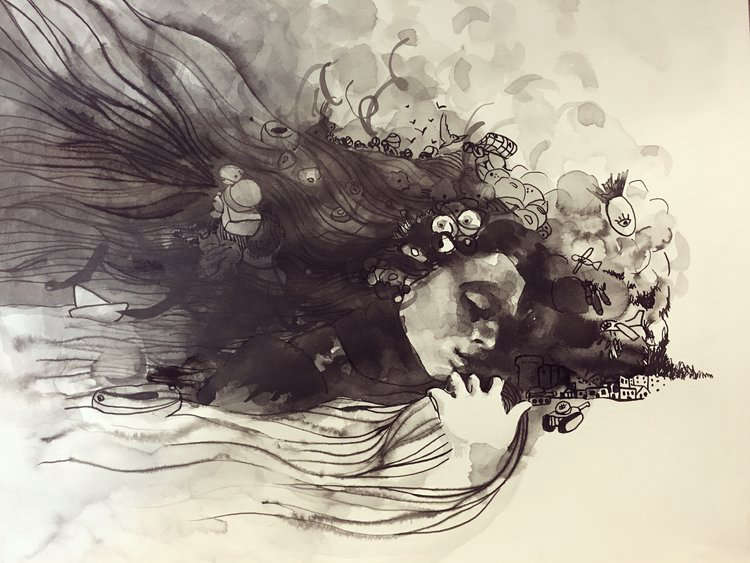
Along this vein, the Nakba turns into a connective link rather than a factor of fragmentation. It is transformed into a tool of networking among ripped-apart Palestinian entities, thanks to their experience of the event and the sharing of the same pain and loss. It amounts to an anchor of Palestinian identity whose revival is unified. It is transformed into a field to rewrite what is common among Palestinians and to reinstate Palestine, which has been absent behind the political projects embraced by parallel Palestinian entities.
The Nakba has affected all Palestinians and has left us scattered and deprived of our basic rights. Until today, the Nakba reflects our unified and open wound. It has to be given the right to be expressed. The ruins will also have the right to dominate the archive… the archive of us all!
*Translated from Arabic by Yasseen al-Sayed.

